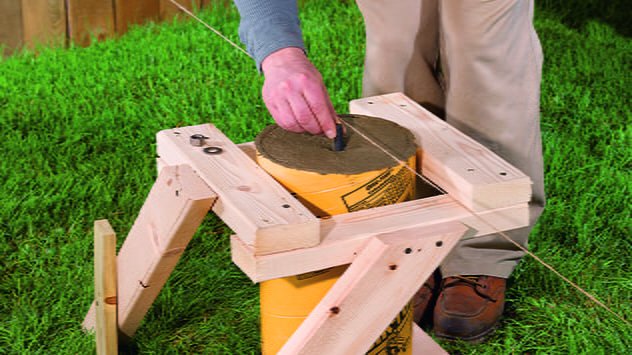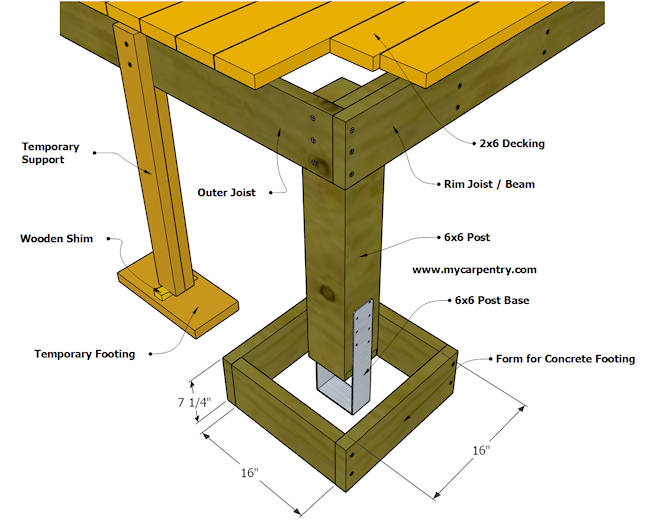Some Known Details About Deck Footings
Table of ContentsThe Ultimate Guide To Deck FootingsA Biased View of Deck FootingsThe 20-Second Trick For Deck FootingsThe Ultimate Guide To Deck FootingsGetting The Deck Footings To WorkDeck Footings for Beginners
Ensuring that the deck doesn't swiftly rot, fall, or tip, and also blow away in solid winds. You require one ground and/or support block for every angle of the deck.12 inches underground is the recommended and also required deepness of the grounds for ground-level decks. Some systems and also free-standing decks can be sustained by concrete blocks rather than grounds.Depending upon the design of your deck, these may not be one of the most attractive option so you may want to spend a little added on having them covered. Again, possibly you like the rugged concrete look! The pier blocks were made especially for floating decks so they're a popular choice.
Not generally seen on a specialist quality deck. A more expensive but much more attractive DIY alternative is the wood blog post anchor. A terrific choice to help avoid premature rotting and also is fast and also simple to mount. If you have an excellent hammer, you can quickly mount these anchors in the ground without requiring to dig or spend anymore cash on crushed rock.
Deck Footings Can Be Fun For Everyone
Some, which may be of interest to you and your design style, can be painted. You could desire to inspect the firmness of your ground area where you intend to build your deck prior to heading out and also acquiring this alternative as it's basically a huge spike that needs compelled down right into the ground.
This is most definitely a much more irreversible, long-lasting remedy that we here TNT are a lot more prone to make use of for the bulk of our projects big or tiny. This option doesn't require you to damage the financial institution, however it does need a little bit of sweat equity as we dig every one of our caissons to at the very least the 30" frost mark for Northern Colorado.
Below at TNT Residence Improvements, we have actually got the big-boy tools like gigantic two-man augers that can make the work of punching 10+ holes in your lawn zip in just a hr or more. On every outside deck we build, we use pressure-treated lumber for the framing of the structure.
The Facts About Deck Footings Uncovered
I'm having a builder put a connected deck on my house. To save money on the project, I'll be excavating the holes for the - Deck Footings. On television as well as in publications, I've seen what appears to be a shift toward using a bell-shaped add-on at the base of each pier when building a deck or other similar project.
Spread-base footings additionally may be needed if your soil is unstable. requirements for soil-bearing capability are traditional, so there's no terrific advantage to utilizing grounds bigger than what you require (Deck learn this here now Footings). I concur with you that there's no factor in digging greater than you have to, specifically he said if you're doing it by hand.
When the ground form is filled partway with concrete, the bag broadens to fill all-time low of the hole without climbing the beyond the kind. If you do make use of a spread-base form, it deserves thinking about the diameter of the ground tube you give quality. Deck Footings. Oftentimes, a 6-in.
All About Deck Footings
tube may practically be ample, but the tiny financial savings in concrete may not counter the other potential frustrations. If you are simply slightly off with the place of a 6-in. footing tube, a 44 deck blog post may overhang the edge of the concrete pier. For the little amount of extra concrete, a 10-in.- dia.
Something failed. Wait a minute as well as try once again Attempt once more.
Not just is including a deck to your residence wonderful for having a good time, yet it'll do marvels for your residence's value. Selecting the site as well as the dimension, along with what you are mosting likely to utilize it for, are all points that you have to think about when thinking of the addition.
Getting My Deck Footings To Work
For those that do not know what footings are, they are a vital part throughout deck construction since they offer the structure that will certainly sustain your deck. Big decks that are connected to the home should constantly have grounds due to the fact that they act to spread the hefty tons of the deck from the surface of a support message over a big surface of the soil so the ground can properly sustain it.

As discussed in the past, it's always an excellent suggestion to have your big decks supported by grounds to make sure that it does not obtain destroyed after you invested a great deal of money building it. But this regulation only really puts on huge decks because smaller sized decks that are a couple of inches off of the ground can sit firmly on cinder block, which must be reinforced with find here some rebar.
Top Guidelines Of Deck Footings

You can either utilize small cinder block and also planks, or you can utilize a post that sets right into a pre-formed hole. Currently that we understand that grounds aren't necessary when building smaller decks close to the ground, it's vital to comprehend what you can utilize instead of footers that will save you time as well as initiative.
Rather of making use of footings, including a level of crushed rock will offer you the water drainage aspect you are trying to find. You can after that add a structure of timber that supports in concrete obstructs that rest in the gravel, producing your new deck (Deck Footings). Cinder blocks will not rot, making them an optimal alternative for those who don't want to use timber.
By doing this, you're mosting likely to wish to install sleepers, which are pieces of pressure-treated lumber, into the concrete so the deck has something to connect to. You can likewise combine this method with the crushed rock one, where the timber sleepers are laid on the gravel (needs to have a layer of sand listed below it) which will supply extra drain.